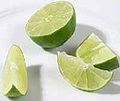Lime (fruit)
| Lime | |
|---|---|

| |
| Unripened Key limes | |
| Scientific classification | |
| Kingdom: | |
| Division: | |
| Class: | |
| Subclass: | |
| Order: | |
| Family: | |
| Genus: | |
| Nutritional value per 100 g (3.5 oz) | |
|---|---|
| Energy | 126 kJ (30 kcal) |
11 g | |
| Sugars | 1.7 g |
| Dietary fiber | 3 g |
0.2 g | |
0.7 g | |
| Vitamins | Quantity %DV† |
| Vitamin C | 32% 29 mg |
| Other constituents | Quantity |
| Water | 88 g |
| †Percentages estimated using US recommendations for adults,[1] except for potassium, which is estimated based on expert recommendation from the National Academies.[2] | |
Lime is a term referring to a number of different fruits (generally citruses), both species and hybrids, which are typically round, green to yellow in color, 3–6 cm in diameter, generally containing sour pulp, and frequently associated with the lemon. Limes are often used to accent the flavors of foods and beverages.
Uses
Drinks
Lime fruit, and particularly their juice, are used in beverages, such as limeade (akin to lemonade). Alcoholic beverages prepared with limes include cocktails such as gin and tonic, margarita, mojito, Caipirinha and Cuba libre, as well as many drinks that may be garnished with a thin slice of the fruit or corkscrew strip of the peel (twist). One customary consumption of tequila is in shots accompanied by lime wedges and salt. Beer is often served with limes in Mexico. Lime juice is also used in some commercial soft drinks.
Cooking
In cooking, lime is valued both for the acidity of its juice and the floral aroma of its zest. It is used in Key lime pie, a traditional Florida dessert, and is a very common ingredient in authentic Mexican, Southwestern United States and Thai dishes. It is also used for its pickling properties in ceviche. Additionally, the leaves of the Kaffir lime are used in southeast Asian cuisine. The use of dried limes as a flavouring is typical of Persian cuisine and Iraqi cuisine. Limes are also an essential element in Tamil cuisine.
Other uses
In order to prevent scurvy during the 19th century, British sailors were issued a daily allowance of citrus such as lime (presumably Citrus aurantifolia)[citation needed], which led in time to the nickname "limey" for all Britons. It was later discovered that this beneficial effect derived from the quantities of Vitamin C the fruit contains.
Lime extracts and essential oils are frequently used in perfumes, cleaning products, and aromatherapy.
Production trends

According to FAO, Mexico produced almost 12% of the global output of lemons and limes in 2005 followed by India, Argentina, Iran and Brazil.
Plants known as "lime"
- Australian limes
- Australian desert lime (Citrus glauca)
- Australian finger lime (Citrus australasica)
- Australian round lime (Citrus australis)
- Blood lime
- Kaffir lime (Citrus hystrix) (a.k.a. kieffer lime; makrut, or magrood)
- Key lime (Citrus aurantifolia) (a.k.a. Mexican, West Indian, or Bartender's lime)
- Mandarin lime (Citrus limonia)
- Musk lime (X Citrofortunella mitis)
- Palestine sweet lime (Citrus limettioides)
- Persian lime (Citrus x latifolia) (a.k.a. Tahiti or Bearss lime)
- Spanish lime (Melicoccus bijugatus) (a.k.a. mamoncillo, mamón, ginep, quenepa, or limoncillo) (not a citrus)
- Sweet lime (Citrus limetta) (a.k.a. sweet limetta, Mediterranean sweet lemon)
- Wild lime (Adelia ricinella)
- Limequat (lime × kumquat)
- Lime tree (Tilia sp.)
Notes
- ^ United States Food and Drug Administration (2024). "Daily Value on the Nutrition and Supplement Facts Labels". Retrieved 2024-03-28.
- ^ National Academies of Sciences, Engineering, and Medicine; Health and Medicine Division; Food and Nutrition Board; Committee to Review the Dietary Reference Intakes for Sodium and Potassium (2019). Oria, Maria; Harrison, Meghan; Stallings, Virginia A. (eds.). Dietary Reference Intakes for Sodium and Potassium. The National Academies Collection: Reports funded by National Institutes of Health. Washington, DC: National Academies Press (US). ISBN 978-0-309-48834-1. PMID 30844154.
Gallery
-
Kaffir lime fruit
-
Lime wedges are typically used in drinks.
-
Limes are usually used for reference.
-
Grocery store limes
-
Lime and Blossom growing in south Spain.





